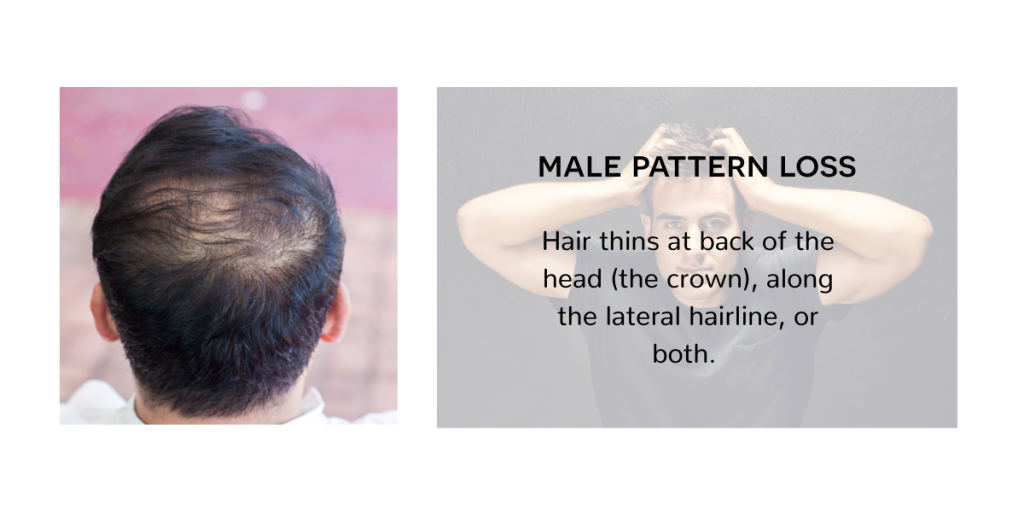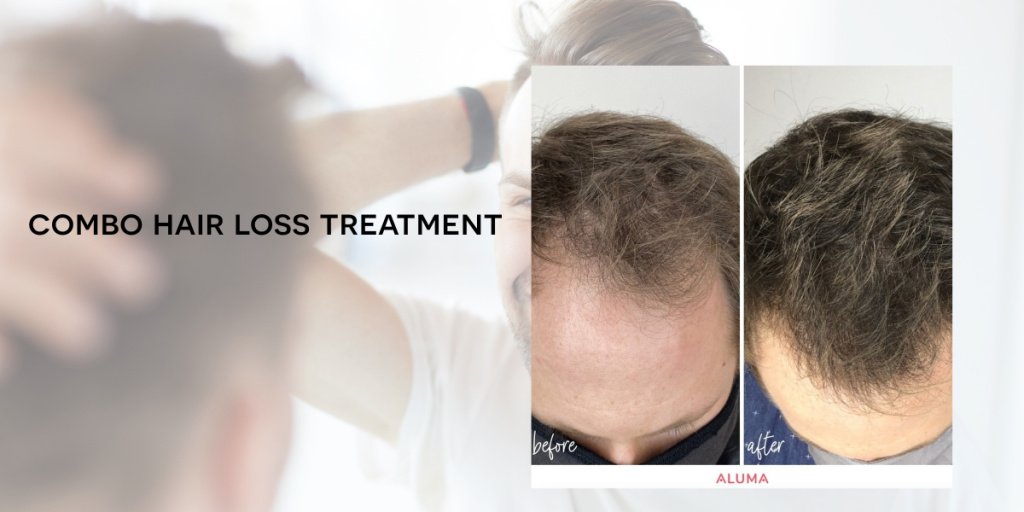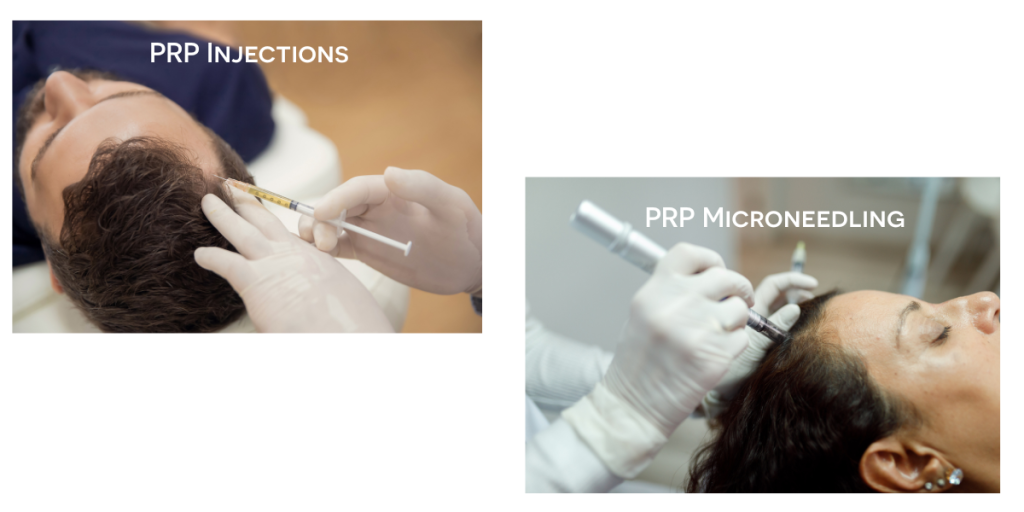Few things are as frustrating as unexpected hair loss. For many, a full head of hair is closely tied to identit and confidence. So, when you begin to notice more hairs on your brush or see your scalp peeking through where it didn’t before, it is understandibly upsetting. The good news is that hair loss is common, and we are getting better at treating it.
Let’s dive into the world of hair – why it’s there, why it might be leaving, and what options exist.
How Hair Grows
Your scalp is home to 100,000 to 150,000 hair follicles—the tiny but mighty structures where every strand of hair starts and completes its growth cycle.
Anagen Phase – This is the active growth phase, during which your hair is growing from the follicle. At any given time, about 90% of your hair is in this stage. This phase can last anywhere from 2 to 7 years.
Catagen Phase – This is a brief, transitional phase that lasts a couple of weeks. Hair growth stops and the follicle begins to shrink. Only a small percentage of hairs are in this stage at one time.
Telogen Phase – This is a resting period that lasts about 2 to 3 months. After this phase, the hair is naturally shed. Once the old hair falls out, a new hair begins growing in its place, starting the cycle again. FYI- Shedding 50 to 150 hairs a day is totally normal.
Why is My Hair Thinning
Doctors generally categorize hair loss into different types:
Structural Hair Disorders: These involve abnormalities in the hair shaft itself, making the hair brittle and prone to breakage. This isn’t a problem with the follicle or cycle, but rather with the strength of the hair strand.
Cicatricial Alopecias/ Scarring Alopecias: These conditions cause permanent damage to the hair follicle, leading to irreversible hair loss. The follicular opening (where hair emerges) is lost.
Nonscarring Alopecias: In these cases, the hair follicle isn’t permanently destroyed, so hair regrowth is possible. This includes male and female pattern hair loss—what most people refer to as “thinning” or “balding.”
Female Pattern Hair Loss

Female Pattern Hair Loss (FPHL) usually shows up as gradual thinning across the top of the scalp, often first noticed as a widening part.
Over time, thick, pigmented terminal hairs—which typically have deeper roots and longer growth cycles—can begin to shrink. They gradually become shorter, finer, and lighter, eventually resembling vellus hairs—the soft “peach fuzz” that covers most of your body and helps regulate temperature.
The exact cause of female pattern hair loss (FPHL) isn’t fully understood, but we do know multiple factors influence it, such as genetics, aging, and hormonal shifts—especially after menopause. Despite its older name, “androgenetic alopecia,” most women with FPHL have normal hormone levels, suggesting a more complex process than androgens alone.
Male Pattern Hair Loss

Male Pattern Hair Loss (MPHL) develops gradually over time and follows a recognizable pattern.
Unlike the diffuse thinning often seen in female pattern loss, MPHL usually presents as a receding hairline, thinning at the crown, or both. Over time, these areas may progress to more extensive baldness, with the sides and back of the scalp often spared.
Hair loss in Male Pattern Loss is strongly influenced by androgens, particularly dihydrotestosterone (DHT). In genetically susceptible men, DHT binds to receptors in hair follicles, causing them to shrink (a process called miniaturization). This results in shorter, finer hairs over time.
The First Step to Successful Hair Loss Treatments
If you’re concerned about hair thinning or hair loss, the most important first step is to see a qualified healthcare professional. While it’s tempting to jump straight into treatments or over-the-counter remedies, getting the right diagnosis is essential for effective and lasting results.
Hair loss can stem from many causes: genetics, hormones, medical conditions, stress, or even nutritional deficiencies. Accurate diagnosis leads to targeted treatment, which means you’re more likely to see results and avoid wasting time or money on therapies that won’t help your specific type of hair loss.
Treatment Goals

When it comes to treating hair loss, the primary goals are twofold: to slow or stop further hair loss and, ideally, to stimulate the growth of thicker, healthier hair. While many treatments can be effective, it’s important to approach the process with realistic expectations.
Hair restoration is a long-term commitment, not a quick fix. Results vary from person to person, and consistency is key. Most people won’t notice visible improvements right away—it often takes four to six months or more before you begin to see meaningful changes. That’s why starting early is so important. The sooner we intervene, the better chance we have at preserving your existing hair and supporting new growth.
Treating Hair Loss with Prescription Medications
1. Topical Minoxidil: Minoxidil is a well-established, first-line treatment for hair loss, with strong evidence supporting its effectiveness. It is applied directly to the scalp and works by prolonging the hair growth phase and enlarging miniaturized follicles. Temporary shedding may occur in the first few weeks as new hairs push out old ones—this is normal and not a reason to stop. Consistent use is key, and visible results typically appear after 4+ months.
2. Oral Minoxidil: Oral minoxidil is becoming a popular alternative for people who experience scalp irritation from topical versions or simply prefer to avoid the hassle and mess of daily application. Originally developed as a blood pressure medication, it has gained popularity in low doses (typically around 0.25 mg per day) for treating hair loss. Early studies and clinical experience suggest it can be effective at promoting hair growth and improving hair density. While generally well-tolerated at low doses, the most common side effect is unwanted body hair growth (hypertrichosis), which is usually fine and light and tends to resolve gradually if the dose is reduced or the medication is discontinued. Though still considered an off-label use, low-dose oral minoxidil is gaining recognition as an effective treatment option.
3. Oral Antiandrogens: Oral anti-androgens are commonly used to treat hormone-related hair loss, often alongside topical treatments like minoxidil. These medications help block the effects of androgens (male hormones) that can contribute to hair thinning.
- Spironolactone – helps by blocking androgen hormones. It takes time to work, usually at least six months. Side effects can include menstrual changes, fatigue, or headache. It should not be used during pregnancy.
- Finasteride – works by lowering levels of dihydrotestosterone (DHT)—the hormone largely responsible for shrinking hair follicles in genetically susceptible men. It’s often considered more effective than topical minoxidil alone. Possible side effects include sexual dysfunction (such as reduced libido or erectile issues), breast tenderness, or gynecomastia. It may also impact PSA levels, which are used in prostate cancer screening. Importantly, finasteride is teratogenic and should not be used or handled by pregnant individuals. There is ongoing discussion about a potential link to psychiatric side effects, especially in younger men, though more research is needed.
- Dutasteride – works by blocking both types of the enzyme responsible for producing DHT, the hormone that causes hair follicle shrinkage. Some studies suggest that dutasteride may be more effective than finasteride, although there is less long-term safety and efficacy data available. Its side effects are similar to those of finasteride, and it carries the same important pregnancy warnings—it should not be used or handled by pregnant individuals.
When Prescription Treatments Aren’t Enough
Additional hair treatments include:
Platelet-Rich Plasma (PRP) Therapy involves drawing a small amount of your blood, processing it to concentrate the platelets, and then microneedling or injecting this platelet-rich plasma into the scalp. The goal is to deliver growth factors that may stimulate hair follicles, promote healing, and encourage new hair growth. While some studies show promising results—such as improved hair density and thickness—research is still evolving, and more high-quality clinical trials are needed to fully establish its effectiveness and optimal treatment protocols.

Low-Level Laser Therapy (LLLT) / Photobiomodulation utilizes specialized, professional devices, such as caps, that emit low-level red or near-infrared light to the scalp. This light is believed to stimulate cellular activity in hair follicles, increasing blood flow and promoting hair growth. Some clinical studies have demonstrated that LLLT can enhance hair density and thickness, making it a promising non-invasive option for addressing hair loss.
Hair Transplantation is a surgical treatment option for individuals who haven’t achieved desired results with medical therapies. It involves harvesting healthy hair follicles from areas of the scalp that are resistant to pattern hair loss—typically the back and sides—and transplanting them into thinning or bald areas. This procedure can offer a permanent improvement in hair density and appearance. However, it requires a significant investment of time and money, and ongoing medical treatments are usually recommended afterward to help maintain the health of the surrounding native hair and optimize long-term results.
Supplements: There is limited evidence supporting the effectiveness of supplements like biotin, iron, ginseng, saw palmetto, green tea, and caffeine for female pattern hair loss (FPHL).
The Bottom Line on Hair Loss Treatments
Hair loss can be complex, but pattern hair loss—both female (FPHL) and male (MPHL) types—is one of the most common and treatable forms. While it typically progresses slowly, leading to thinning and reduced coverage, it rarely results in complete baldness like some scarring hair disorders can.
At Aluma, we often begin treatment with oral minoxidil for those experiencing mild to moderate hair loss. For more advanced cases, we’ve seen excellent results using a layered approach that combines oral minoxidil with PRF microneedling to stimulate regrowth from multiple angles.
If you’re ready to take the next step, book a consultation with Dr. Brigham at Aluma Aesthetic Medicine. Together, we’ll explore your goals and create a customized plan to help restore your hair—and your confidence.
We also monitor your progress with before-and-after photos and regular check-ins to track your results and make adjustments as needed.
Note: We recognize that hair thinning and pattern loss can affect people across the gender spectrum. Unfortunately, there is currently limited research on pattern hair loss in transgender and nonbinary individuals, and we acknowledge that this important information is missing from this article. Our goal is to provide compassionate, evidence-based care and education that respects all identities and experiences, and we hope future studies will address these gaps in understanding.
Citations:
Ramadan, Wafaa Mohammad, et al. “Evaluation of Adding Platelet-Rich Plasma to Combined Medical Therapy in Androgenetic Alopecias.” Journal of Cosmetic Dermatology, vol. 20, no. 5, 2021, pp. 1427–1434.
Bergfeld, Wilma, et al. “A Phase III, Multicenter, Parallel-Design Clinical Trial to Compare the Efficacy and Safety of 5% Minoxidil Foam Versus Vehicle in Women With Female Pattern Hair Loss.” Journal of Drugs in Dermatology, vol. 15, no. 7, 2016, p. 874.
Burns, L.J., et al. “Spironolactone for Treatment of Female Pattern Hair Loss.” Journal of the American Academy of Dermatology, vol. 83, no. 1, 2020, p. 276.
Manabe, M., et al. “Guidelines for the Diagnosis and Treatment of Male-Pattern and Female-Pattern Hair Loss, 2017 Version.” Journal of Dermatology, vol. 45, no. 9, 2018, p. 1031.

